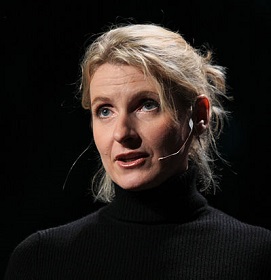De Amerikaanse schrijfster en essayiste Elizabeth M. Gilbert werd geboren op 18 juli 1969 in Waterbury, Connecticut. Haar vader was chemisch ingenieur en haar moeder verpleegster. Ze groeide op in een klein gezin samen met haar enige zus, de schrijfster en historica Catherine Gilbert Murdock. Ze woonden in Litchfield , Connecticut, zonder buren, televisie of muziekspeler. Bijgevolg lazen ze veel. Gilbert en haar zus vermaakten zich met het schrijven van kleine boeken en toneelstukken. Gilbert behaalde in 1991 een diploma Bachelor of Arts in de politieke wetenschappen aan New York University. Vervolgens ging ze aan de slag als kokkin, tafelbediende en werknemer bij een tijdschrift. Het Amerikaanse tijdschrift Esquire publiceerde haar kortverhaal “Pilgrims” in 1993 onder de kop “The Debut of an American Writer”. Daarmee was ze de eerste niet-gepubliceerde schrijver van korte verhalen die in Esquire haar debuut maakte sinds Norman Mailer. Vanaf dat moment kon ze zich toeleggen op serieus journalistiek werk in opdracht van een hele serie nationale tijdschriften zoals SPIN, GQ, The New York Times Magazine, Allure, Real Simple en Travel + Leisure. In haar memoires Eat, Pray, Love geeft ze te kennen dat ze carrière maakte als een goed verdienende freelance-schrijver. Voor “Pilgrims” ontving ze de Zacharis Award van 1999. In 1998 vormde ze haar GQ-artikel “Eustace Conway is Not Like Any Man You’ve Ever Met” om in een biografie van de moderne naturalist getiteld “The Last American Man”. Deze werd genomineerd voor de National Book Award in de categorie non-fictie. In 2006 bracht Gilbert Eat, Pray, Love: One Woman’s Search for Everything Across Italy, India and Indonesia uit. Het vertelt haar verhaal over haar jaar van “spirituele en persoonlijke verkenning” tijdens haar reizen in het buitenland. De verfilming van Eat, Pray, Love ging uit van Columbia Pictures en werd vervolgens onder dezelfde titel uitgebracht op 13 augustus 2010. De actrice Julia Roberts speelt de rol van Elizabeth Gilbert. Haar vijfde boek “Committed: A Skeptic Makes Peace with Marriage” kan beschouwd worden als het vervolg op “Eat, Pray, Love”. Het is een diepgaand onderzoek van het instituut van het huwelijk vanuit meerdere historische en hedendaagse perspectieven.
Uit: Eat, Pray, Love
„I wish Giovanni would kiss me.
Oh, but there are so many reasons why this would be a terrible idea. To begin with, Giovanni is ten years younger than I am, and—like most Italian guys in their twenties—he still lives with his mother. These facts alone make him an unlikely romantic partner for me, given that I am a professional American woman in my mid-thirties, who has just come through a failed marriage and a devastating, interminable divorce, followed immediately by a passionate love affair that ended in sickening heartbreak. This loss upon loss has left me feeling sad and brittle and about seven-thousand years old. Purely as a matter of principle, I wouldn’t inflict my sorry, busted-up old self on the lovely, unsullied Giovanni. Not to mention that I have finally arrived at that age where a woman starts to question whether the wisest way to get over therthe loss of one beautiful brown-eyed young man is indeed to promptly invite another one into her bed. This is why I have been alone for many months now. This is why, in fact, I have decided to spend this entire year in celibacy.
To which the savvy observer might inquire: “Then why did you come to Italy?”
To which I can only reply—especially when looking across the table at handsome Giovanni—”Excellent question.”
Giovanni is my Tandem Exchange Partner. That sounds like an innuendo but un-fortunately is not. All it really means is that we meet a few evenings a week here in Rome to practice each other’s language. We speak first in Italian, and he is patient with me; then we speak in English, and I am patient with him. I discovered Giovanni a few weeks after I arrived in Rome, thanks to that big Internet café at the Piazza Barberini, across the street from that fountain with the sculpture of that sexy merman blowing into his conch shell. He (Giovanni, that is—not the merman) had posted a flier on the bulletin board explaining that a native Italian speaker was seeking a native English speaker for conversational language practice. Right beside his appeal was another flier with the same request, word-for-word identical in every way, right down to the typeface. The only difference was the contact information. One flier listed an e-mail address for some-body named Giovanni; the other introduced somebody named Dario. But even the home phone number was the same.”

